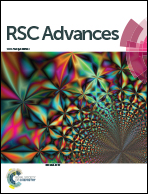Synthetic application of gold nanoparticles and auric chloride for the synthesis of 5-substituted 1H-tetrazoles†
Abstract
An effective one-pot, convenient gold catalyzed synthesis of 5-substituted 1H-tetrazoles has been discussed. The study demonstrated the comparative overview for utilization of gold(III) and gold nano-particles (spheres) as a catalyst. Detailed understandings of the mechanism, surface area effect (in reference to nanoparticles) of gold in the activation of nitriles for nucleophilic (3 + 2) cycloaddition of sodium azide to give the product have also been studied.


 Please wait while we load your content...
Please wait while we load your content...